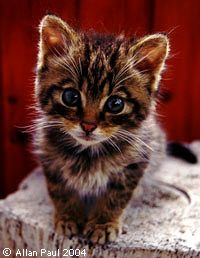Wildcat risks extinction through cross-breeding
By Charles Clover, Environment Editor in the Daily Telegraph, 26 th April 2004
 The Scottish wildcat is being pushed towards the brink of extinction
because of loopholes in the law and cross-breeding with domestic
cats, says a report published today. The Scottish wildcat is being pushed towards the brink of extinction
because of loopholes in the law and cross-breeding with domestic
cats, says a report published today.
Between 1,000 and 4,000 wildcats are thought to survive in the
mountains of northern Scotland but estimates vary widely because the
definition of a true wildcat is disputed.
This uncertainty has hampered the conservation of the species,
according to the report, The State of Britain's Mammals 2004 by the
charity Mammals Trust UK.
By the tightest definition of a "true" wildcat - which involves a
comparison with a specimen in the Natural History Museum in
London stuffed in 1904 and other representative specimens - as few as
400 pristine, pre-Iron Age-type, wildcats are thought to survive.
No one can be sure whether the museum specimens - with their
tabby-like markings but a much thicker, black banded tail - represent
the full variation originally found in pristine "classical" wildcats, since
domestic cats, which are very closely related, were introduced with the
Romans.
There were 2,000 years of opportunities for cross-breeding before the
early museum specimens died, so there is no way of knowing whether
one with, say, a particular stripe variation, or even white paws, could
have occurred in the wild before hybridisation began.
Since a 1990 court case over the killing of an alleged wildcat cast
doubt on the capacity of expert witnesses to identify wildcats, the
protection given to the species by the Wildlife and Countryside Act has
been ineffective.
Since moorland gamekeepers legitimately kill feral cats, there are
concerns that some wildcats, along with wildcat hybrids, may have
been killed while this loophole has existed.
The trust's report calls for legal protection of the wildcat to be upgraded urgently and for the wildcat to be recognised as a "priority species" under the Government's Biodiversity Action Plan.
Prof David Macdonald of Oxford University's Wildlife Conservation Research Unit and an author of the report, is soon to publish an action plan advocating the protection of both those with pristine wildcat characteristics and possible hybrids. In protection areas for wildcats, it recommends "any striped tabby cat with a bushy tail and a black tip would be given the benefit of the doubt and treated as protected".
© Daily Telegraph, 26 th April 2004
|





